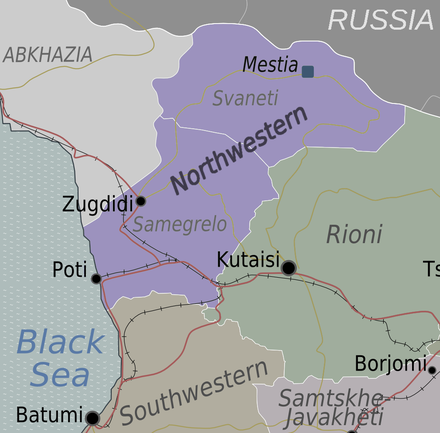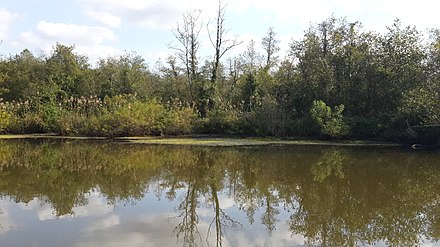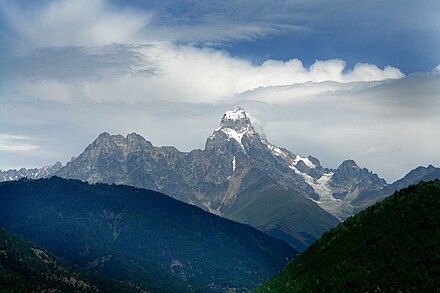Northwestern Georgia
Northwestern Georgia is a region of the country of Georgia.
Cities

-
Mestia – The "capital" of Svaneti
-
Zugdidi – The capital of Samegrelo, and mostly gateway to Mestia and Abkhazia.
-
Anaklia and Ganmukhuri – Black Sea villages nearby Zugdidi (34 km). During the last few years these villages have become fancy, touristic resorts. Some high class hotels, pubs and casino were built. It's a good place to enjoy the Black Sea.
-
Jvari – A small town with a couple of excellent attractions nearby, like the Enguri Dam, the Omune Observation Tower, the Intsira Waterfall, and the Lia fortress ruins.
-
Martvili – Popular for canyoning and whitewater rafting.
-
Mazeri 📍 – A stunningly beautiful mountain village. The starting point for Svaneti Mount Ushba trekking.
-
Poti – A fairly uninteresting port city, albeit one with an interesting ancient history. Headquarters of the Georgian Navy. Also serves as an entrance point to Kolheti National Park.
-
Ushguli – Perhaps the most picturesque Svan village, at the bottom of Georgia's highest mountain, it is also a .
Other destinations
- Three of the seven components making up the natural world heritage site Colchic Rainforests and Wetlands; Churia 📍, Nabada 📍 and Pitshora 📍 are in this region (the others are in Southwestern Georgia).
Understand
Northwestern Georgia coincides with the administrative regions Samegrelo. and Svaneti. of Georgia. Svaneti is divided into two parts, Upper Svaneti and Lower Svaneti, separated by the tall Svaneti Mountain Range.
 Northwestern Georgia is a very diverse region, which, due to its many languages, cultures, and even governments, can feel like several different countries. The Svans of Svaneti and the Mingrelians of Samegrelo are Christian, Georgian sub-ethnic groups who have cultures and languages distinct from, but closely related to Georgian. The Abkhaz, however, are a completely unrelated South Caucasian people, who for much of their history were predominantly Muslim, until the Russian Empire's "Muhajarism" practice in the 19th century of mass deportation of Muslim Caucasian peoples, which cleansed the region of nearly all non-Orthodox Abkhaz.
Northwestern Georgia is a very diverse region, which, due to its many languages, cultures, and even governments, can feel like several different countries. The Svans of Svaneti and the Mingrelians of Samegrelo are Christian, Georgian sub-ethnic groups who have cultures and languages distinct from, but closely related to Georgian. The Abkhaz, however, are a completely unrelated South Caucasian people, who for much of their history were predominantly Muslim, until the Russian Empire's "Muhajarism" practice in the 19th century of mass deportation of Muslim Caucasian peoples, which cleansed the region of nearly all non-Orthodox Abkhaz.
The culture of Svaneti is intriguing, offering some of Georgia's most solemn and mysterious dances, and the most complex polyphonic singing in the Caucasus—a tradition dating back over two millennia. There are absolutely no regular performances of any kind, and there are no performance venues besides the open air under the Greater Caucasus, or perhaps in someone's modest home. You are more likely to experience Svan performances in Tbilisi, but a really great guide may set something up with the help of local friends.
History
Since Georgian independence in 1991, Northwestern Georgia has been a hotbed of complicated political violence and conflict. The first president of Georgia, Zviad Gamsakhurdia, was an ethnic Mingrelian with ties to Samegrelo. His presidency was intensely controversial within and without Georgia and sparked a civil war, which quickly resulted in a murky coup d'etat in late 1991. Conflict between pro-Gamsakhurdia and anti-Gamsakhurdia forces continued as a new separatist conflict exploded in Abkhazia in 1992. The Abkhaz military, fighting alongside paramilitaries from the North Caucasus (and possibly with help from the Russian government) defeated the Georgian military in September 1993, allowing the Abkhaz government to establish de facto independence.
In an even more strange and convoluted twist, Gamsakhurdia then returned to Georgia from Chechnya in late 1993, set up a government-in-exile in Zugdidi, and began a full scale civil war with the central government, relying on the support of Samegrelo and Abkhazia. Gamsakhurdia's war was very successful and his forces routed the Georgian military and threatened the capital. But the resulting instability threatened Russian interests and the Russian government sent its military to the aid of the central government, resulting in a quick defeat for Gamsakhurdia's forces, the firm establishment of Georgia's Shevardnadze government, and the mysterious death of Gamsakhurdia himself. But Northwestern Georgia never really accepted the Shevardnadze victory, leaving the Samegrelo region into a turbulent, volatile center of unrest. The central government struggled to control the Samegrelo region throughout the presidency of Eduard Shevardnadze (1992–2003). Moreover, the wide-scale ethnic cleansing of Abkhazia's ethnic Georgians led to continued low-intensity warfare between Mingrelian paramilitaries and the Abkhaz military. Stability in the region is further undermined by an influx of refugees from the Abkhazian war zone, who are mostly Megrelians.
The most powerful force shaping the region today is the protracted separatist conflict between Abkhazia and the Georgian central government. The current situation is more or less a stalemate. Georgia's president has vowed to reintegrate Abkhazia into Georgia, but only by peaceful means. The Abkhaz government demands nothing less than full de jure independence from Georgia. And the ever important Russian government, which still has peace-keeping troops in the region, gives tacit support to its Abkhaz client government while trying to avoid renewed regional conflict.
Climate
The climate of Northwestern Georgia ranges from subtropical (Samegrelo) to high alpine (Svaneti), and is one of Georgia's greenest, lushest, and wettest regions.
Samegrelo's climate is subtropical with frequent rains. The coastal areas have many marshlands despite the Soviet Georgian authorities' efforts to dry them up. These marshlands contain many rare birds and animals not found in other parts of the country. For this reason, substantial part of the territories is protected by the Georgian law as part of the Colchetian Nature Reserve.
Talk
Although the Georgian languages of Mingrelian in Samegrelo and the unwritten Svan in Svaneti are widespread, Georgian is the main language in the region.
Much of the older generation speak Russian as a second or a third language and the younger generation is increasingly speaking English due to hostility towards Russia, and also because English is taught in schools since independence and has replaced Russian as a second language in schools nation-wide.
When in need for help, look for younger people, as they are more likely to know some English. Speaking Russian is recommended in areas where non-Georgian minorities live. Basic tourism vocabulary is widely understood in Mestia, the regional capital.
Get in
By marshrutka
Marshrutkas head to Zugdidi and on to Abkhazia from the bus stations in Batumi and Kutaisi, and Tbilisi. Poti is the easiest destination to get to, and is widely served by public transport. Marshrutkas also make the long, steep climb from Kutaisi and Tbilisi to the Svan capital, Mestia.
By train
Night trains (8 hr) between Zugdidi and Tbilisi are co-ordinated with early morning (06:00-08:00) marshrutka departures (15 lari) from Zugdidi to Mestia, which take a bit over 3-4 hr. Booking in advance for the train recommended.
By plane
Queen Tamar Airport offers flights to Mestia that are operated by Serviceair.
Get around
By marshrutka
There are basic and inconvenient marshrutka services between towns, but it's generally easier to hire taxis. Most of the drivers will not speak English, but if you state your destination they will usually point you in the right direction.
On foot
In Svaneti, hiking from town to town is possible, and considerably more exciting, There is a flagged path from Mestia to Ushguli passing through several villages, the tourist information in Mestia can give additional information as well as some very detailed hiking maps.
By car
There are reasonably good roads in the region with a new highway built to connect with Mestia. If you have your own transport it will be easy to get around.
See
In addition to the breathtaking ancient villages of Svaneti filled with imposing stone watchtowers, there are some spectacular mountain vistas of Europe's highest mountains. Look especially for Mount Ushba and Mount Shkhara.
The Tower of Love between Mestia and Ushguli is a Svan Tower with a special purpose.
The Enguri Canyon near Totani north of Jvari, before and after Totani village, is worth a stop along the road, when the water from the dam is out.
Near Martvili are the Martvili Canyon, a place of waterfalls, where you could swim, and see the footprints of dinosaurs, and the Dadiani summer palace in Salkhino.
Head to Tsaishi, south of Zugdidi, to experience traditional village life. It has hot mineral springs, the Museum of Iona Meunargia, a Georgian poet and well known public person, a cathedral, picnic on the mountain Urta with amazing views of the Great Caucasus chain, and Djegeta mountain with old church and impressive nature. The hot springs are not maintained by anyone, and only holes in the grassland are available for a dip—you better head to Nokalakevi, whose nearby springs are a real gem.
 Other natural sights:
Other natural sights:
- Skuri caves and mineral water springs
- Mukhuri caves in the middle of the wild Georgian woods with moss rocks and river (swimming place)
- Shurubumu Caves near Jvari
- Lugela waterfalls
Churches and castles:
- Chkondidi (residence of the head of the Orthodox church, a unique monastery, the centre of royal land from the 10th century (near Martvili)
- Nokalakevi Archaeopoliss near Martvili
- Monastery of Khobi near Zugdidi
- Kheta fortress
Various other sights:
- Chkhorotskhu region and its Lebarde resort with mineral waters
- Dida Kirsa, an archaeological place with nice site seeing panorama
- Nodjikhevi, an archeological area with an old fortress and traditional Georgian village atmosphere near Khamiskuri
Do
-
Religious feast of Kvirikoba, on 28 July in Kala, is the best time to visit. Since a lot of people are in the area, you can feel pretty safe in traveling here independently—although it may be difficult to find accommodations. And food at feasts in this part of the world is good.
-
Papantskhvili is lake in mountains where according the legend local priest house with his family drowned. Old Soviet villa of politicians.
-
Mt. Urta, south of Zugdidi, has more than 200 caves, waterfalls, and mountainous rivers, including the Pokori river with waterfalls where you could swim.
-
Nokalakevi Geothermal Park near Martvili is a hidden gem with sulphur fountains, white cascades, and hot river pools.
Hiking
Main article: Hiking in Northwestern Georgia
Northwestern Georgia provides some excellent hiking opportunities, and is a good way to see the natural scenery of the region.
Eat
The food differs from region to region within Northwestern Georgia, but its Mingrelian cuisine is perhaps its most famous, which is notably spicier than most Georgian food, and is just generally delicious.
Kubdari are a local delicacy from this region. These are khachapuri made with spiced mince meat.
Drink
The local wines are actually made of grapes from the Racha region, but any place is a good place to drink them! The best local wines are red, Barakoni and Khvanchkara. The latter was allegedly Stalin's favorite.
Sleep
There are several homestays and guesthouses in and around Mestia and Ushguli, Svaneti. The Tourist information in Mestia has a list of families in other villages (especially between Mestia and Ushguli) which offer a homestay, speaking Georgian or Russian might be an advantage but is not necessary. Georgian and Russian speakers won't have any problem to find a place to sleep by asking people in the villages for an opportunity. Most homestays ask 30 lari (2008) for one night with dinner and breakfast, it may be negotiable. There are guesthouses in Mazeri, Mestia, Zhabeshi, Adishi, Iprali and Ushguli, open during the summer season June until September, catering to eco tourists and hikers.
- Village Adishi Guesthouse (Elisabeth Kaldani's Guest House), +995 595 44 95 84, +995 595 13 51 87, kaldanielizabeth@yahoo.com. Family-run guest house run by fluent English- and Russian-speaking woman. Fantastic meals. Possibility to arrange horse rental for river crossing. 2018-11-25
- Village Zhabeshi: Kakhiani Guesthouse (Luka), +995 551 077 822. Guesthouse run by fluent English- and Russian- speaking young Luka and an old woman. Super-friendly service, clean rooms and the by far cheapest place in town as all the others charge you for room, board and drinks. 30-40 lari for room and board (3 meals) 2017-09-03
Stay safe
 Northwestern Georgia is generally a safe travel destination. The Abkhazia conflict caused some destabilization in the region, but this has largely been settled (not in Georgia's favour). Samegrelo took in a number of the "refugees" from the Abkhazia conflict, but apart from stretching government, education and health resources this has not led to any ongoing security issues. A tourist in Samegrelo should experience no worse problems than in the rest of the country.
Northwestern Georgia is generally a safe travel destination. The Abkhazia conflict caused some destabilization in the region, but this has largely been settled (not in Georgia's favour). Samegrelo took in a number of the "refugees" from the Abkhazia conflict, but apart from stretching government, education and health resources this has not led to any ongoing security issues. A tourist in Samegrelo should experience no worse problems than in the rest of the country.
Svaneti was largely untouched by the conflict to its west. Never truly subdued by any foolhardy invader, even the Soviets failed to subdue the fierce Svan mountain tribes who inhabit these high mountain fortress-villages. Georgians themselves claim to be a little afraid of the natives here. The Svans were once renowned as being an aggressive and insular group, however, this has changed as tourism has boomed. Now the biggest problem tourists will face is rising prices, especially if you are a foreigner or don't speak the local language. On the other hand, if accepted as a guest of a Svan, the Svans are renowned for their legendary hospitality. The security situation improved somewhat after Saakashvili came to power. You should not have any security concerns when visiting Svaneti; it is far too wonderful a travel destination to miss. Travelling to Svaneti is not a big safety risk anymore and is possible for backpackers. However, common security precautions should be taken.
Nervous passengers may want to brace themselves for the marshrutka ride there—the drivers' speeds on the mountain roads certainly aren't for the faint of heart.
Go next
From Svaneti, there is a lonely and poor quality mountain road leading east to the beautiful and safer mountain region of Racha. If you are a hardy trekker, and know what you are doing, you could also head into upper Racha by foot, over mountains. There are routes heading North into Russia's North Caucasus and into Abkhazia, but this should not be attempted. Both borders are closed (although enforcement is impossible), and if caught by the Georgians or the Russians, you will find yourself in trouble and alone in a strange and often cruel land.
Northwestern Georgia
Timezone:MultipleCoordinates:42.55, 42.12